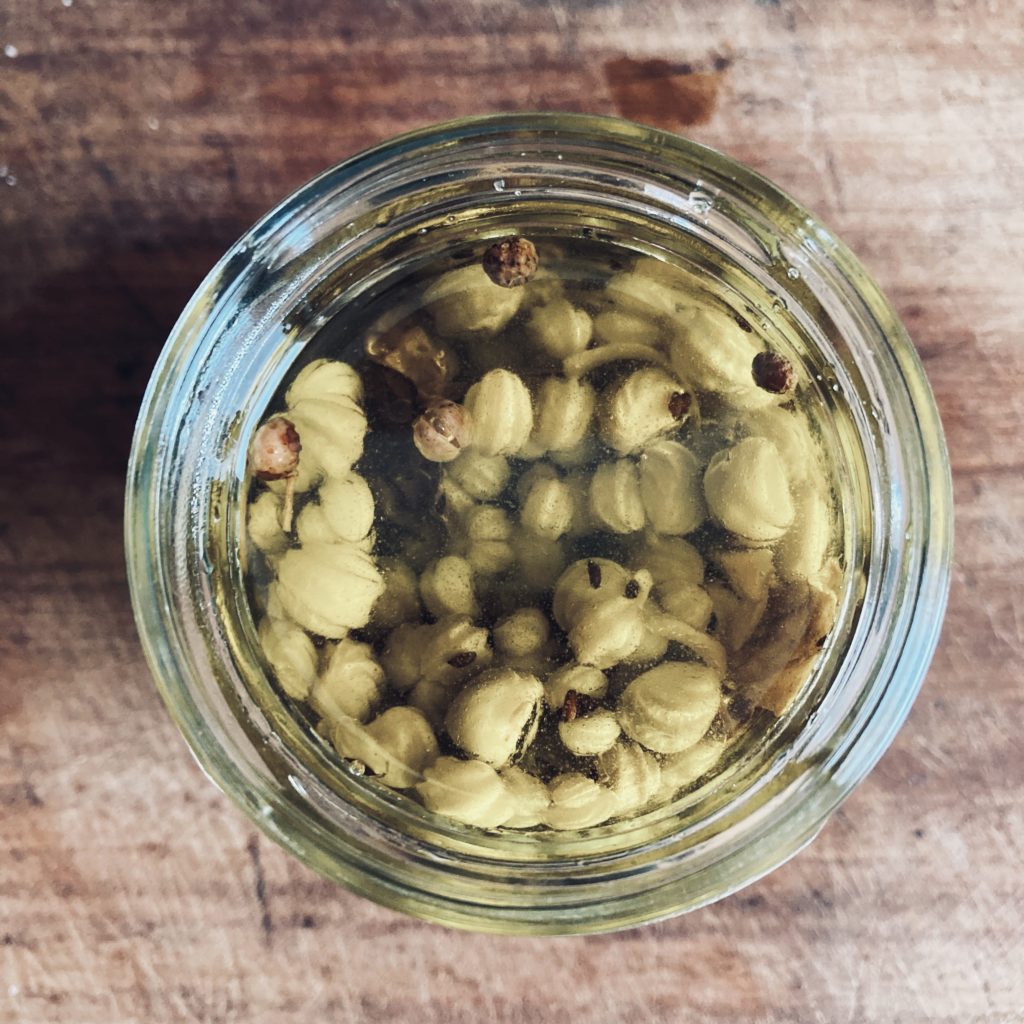Nasturtium is one of my favourite flowering plants. I like it for various reasons but predominantly for its versatility in culinary use, aesthetic values as well as for that amazingly long nectar spur. Just pick one flower, snip of around 1mm at the end of the spur and suck for a sweet sensation. That’s what butterflies and bees gorge on all day long, pretty good isn’t it?


Once the flowers are gone, seeds appear. You can leave them to mature for next season’s planting or pick while still green and eat them like this. Raw seeds are tasty – fermented or pickled are delicious. After processing they it’s not only their flavour that it is transformed. It’s the sun rays and amazingly pungent chemicals that are locked in for you to enjoy during long, dark winter.
Below you will find recipes for preserving nasturtium seeds in spiced vinegar and for pickled nasturtium seeds in olive oil.
PICKLED NASTURTIUM CAPERS (vinegar)


Recipe for 300ml jar.
- good quality vinegar, I‘ve used homemade guilder rose and rosehip made back in 2019
- enough seeds to fill over ¾ of the jar
- teaspoon of salt
- teaspoon of sugar/honey or other source of sugar. I’ve used dandelion honey made back in April.
- spices of choice, I’ve used: garlic mustard seeds, lemon balm, oregano, sweet cicely seeds and hogweed seeds
- water


Wash the capers. In the saucepan mix water and vinegar using the proportions listed below:
Depending on the acidity of your vinegar mix 1 part of vinegar with 2 or 3 parts of water for strong vinegars and mix 1 part of vinegar with 1 part of water for your less acidic vinegars. For strong vinegar I mean 5%-10% vinegar, that’s standard in commercially made produce. For home made you can either calculate it (tricky) or do a taste sampling to determine whether it’s strong or weak.
Add spices, sugar, and salt, then bring to the boil. Add nasturtium seeds and boil for another 2-3 minutes – longer if you have larger, slightly tougher seeds.
Put your hot capers and spices into a clean jar. Then pour enough boiling hot liquid to cover all the plant matter and leave about 1cm space between the lid and the surface of the liquid.
You can turn your jar upside down to pasteurise the lid and to achieve perfect seal. That’s just optional though and you can leave your jars to cool down without turning them upside down. You’ll know that the jar is sealed when lid will become slightly depressed and will make a characteristic ‘’click’’ sound while opening.
Enjoy.
PICKLED NASTURTIUM CAPERS IN OIL
Firstly, I would like to mention that preserving in oil has its dark side. You may find plenty of recipes for pestos, mushrooms and grilled veg in oil. I believe it’s exteremely important to mention that anoxic environment created by oil can create optimal conditions for growth of some potentially dangerous pathogens. I mean Clostridium botulinum. C. botullinum doesn’t develop in pH below 4.5 and that’s why pickling is important. High acidity = low pH, so vinegar, citric and lactic acid are great choices for safely preserving your food.
I will write a separate, more detailed post on how and why to lower the pH of your food which is intended for long term storage. Watch this space and my social media for more tips and recipes.
I suggest to do your own research when preserving veg, meat or fish in oil. There are plenty of scientific papers and alot of guidance from food standard agencies from around the world to keep you right.
When done properly, foods preserved in oil are superb company for your cheese boards, cold meat plates and more.
Big thanks to Monica Wilde and Matthew Rooney who introduced me to this old Italian recipe for preserving mushrooms in oil.

Recipe for 300ml jar.
- enough seeds to fill over ¾ of the jar
- pickling solution made of 1 part of water and 1 part of quality vinegar, salt and sugar to taste. I’ve used 1 tablespoon of salt and 1 tablespoon
- spices of choice, I’ve used: garlic mustard seeds, Sichuan pepper, hogweed seeds, dried onions and semi free morel mushrooms harvested in April this year


Process:
Bring pickling solution to the boil. Add spices, salt, sugar and nasturtium seeds and boil for approx. 10 minutes. The point of boiling is not only to soften the capers but mainly to acidify the plant matter.
Strain capers and spices to get rid of excess moisture. It is a good idea to spread pickled ingredients on a piece of clean paper or cloth. Taste the capers to make sure that they taste acidic. Place all the ingredients in clean jar and cover the contents in oil. I’ve used extra virgin olive oil. I’ve also used 3g of citric acid before adding oil. Just to make sure that the pH is at safe level for long term storage.
You can skip this point if you intend to keep the capers refrigerated and consume quickly but I’ve pasteurised the them for 15 minutes. To do that just fill the saucepan with water, place a cloth on the bottom of the pan, put the closed jar in (the lid has to be above the water) and cover the pot with lid. Bring to the boil, turn heat down and simmer for 15 minutes. Store at room temperature or refrigerate.